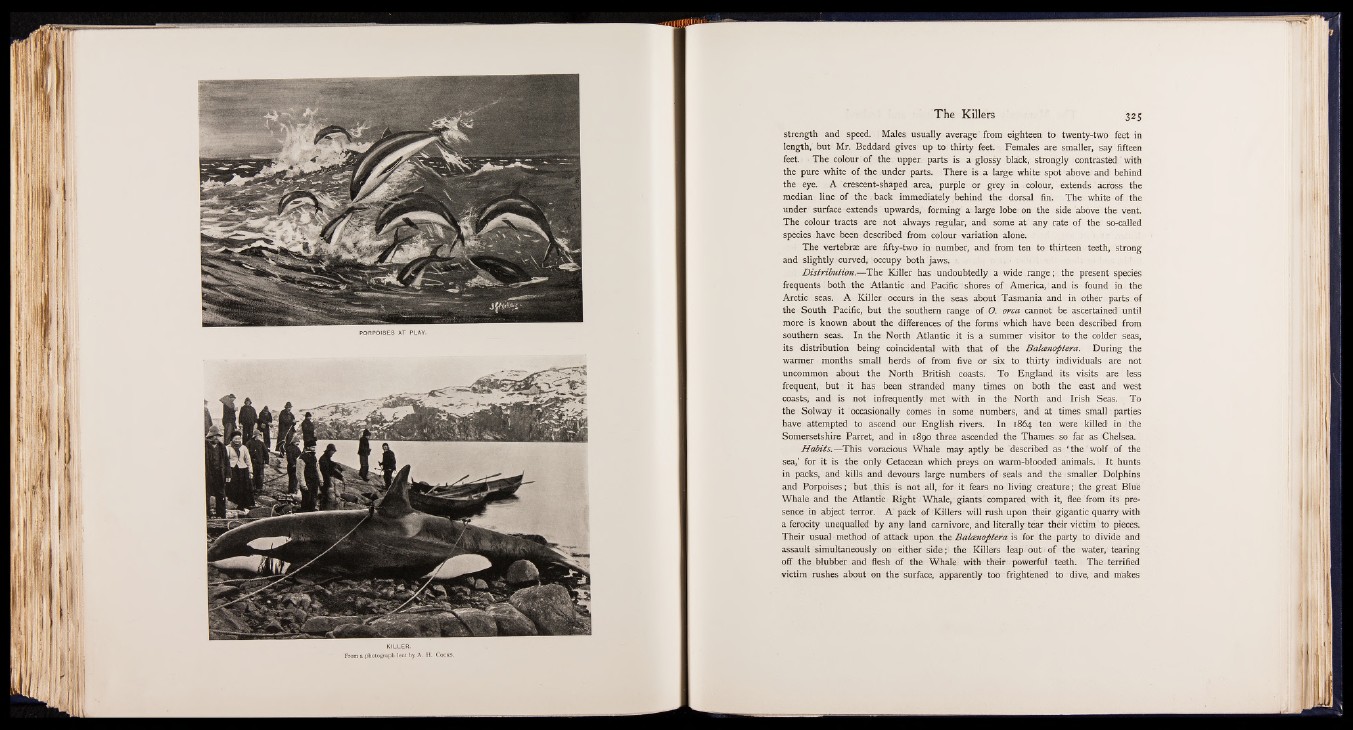
strength and speed. ; Males usually average from eighteen to twenty-two feet in
length, but Mr. Beddard gives up to thirty feet. Females are smaller, say fifteen
feet. The colour of the upper parts is a glossy black, strongly contrasted with
the pure white o f the under parts. There is a large white spot above and behind
the eye. A crescent-shaped area, purple or grey in colour, extends across the
median line of the . back immediately behind the dorsal fin. The white of the
under surface extends upwards, forming a large lobe on the side above the vent.
The colour tracts are not always regular, and some at any rate of the so-called
species , have been described from colour variation alone.
The vertebrae are fifty-two in number, and from ten to thirteen teeth, strong
and slightly curved, occupy both jaws.
Distribution.— The Killer has undoubtedly a wide range; the present species
frequents both , the Atlantic and Pacific shores of America, and is found in the
Arctic seas. A Killer occurs in the seas about Tasmania and in other parts of
the South Pacific, but the southern range of O. orca cannot be ascertained until
more is known about the differences of the forms which have been described from
southern seas. In the North Atlantic it is a summer visitor to the colder seas,
its distribution being coincidental with that of the Balcenoptera. During the
warmer months small herds of from five or six to thirty individuals are not
uncommon about the North British coasts. To England its visits are less
frequent, but it has been stranded many times on both the east and west
coasts, and is not infrequently met with in the North arid Irish Seas. To
the Solway it occasionally comes in some numbers, and at times small parties
have attempted to ascend our English rivers. In 1864 ten were killed in the
Somersetshire Parret, and in 1890 three ascended the Thames, so far as Chelsea.
Habits.—This voracious Whale may aptly be described as ‘ the wolf of the
sea,’ for it is the only Cetacean which preys on warm-blooded animals. It hunts
in packs, and kills and devours large numbers of seals and the smaller Dolphins
and Porpoises; but .this is not all, for it fears no living creature; the great Blue
Whale and the Atlantic Right Whale, giants compared with it, flee from its presence
in abject terror. A pack of Killers will rush upon their gigantic quarry with
a ferocity unequalled by any land carnivore, and literally tear their victim to pieces.
Their usual method of attack upon the Balcenoptera is for the party to divide and
assault simultaneously on either side; the Killers leap, out-of the water, tearing
off the blubber and flesh Of the Whale with their powerful teeth. The terrified
victim rushes about on the surface, apparently too frightened to dive, and makes